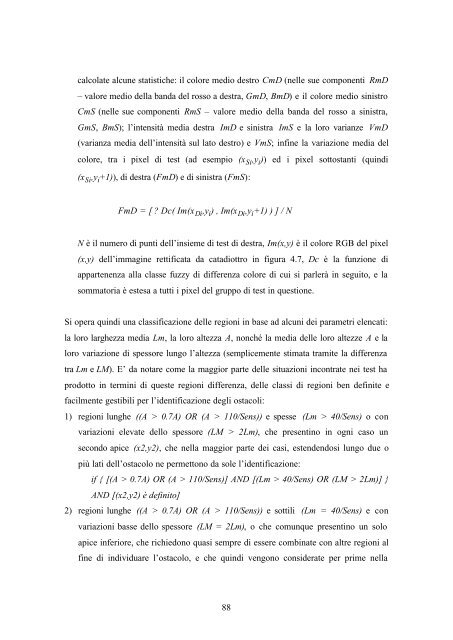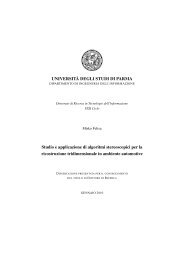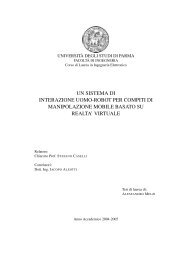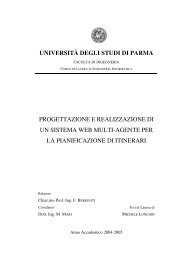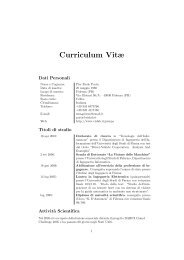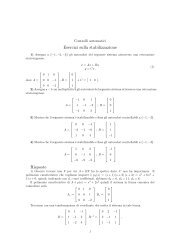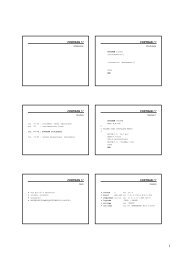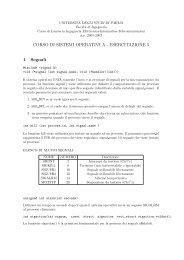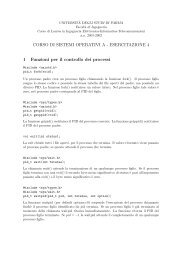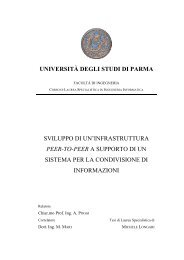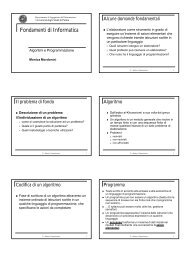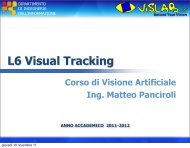Progetto e Realizzazione di un Sensore Ibrido Omnidirezionale/pin ...
Progetto e Realizzazione di un Sensore Ibrido Omnidirezionale/pin ...
Progetto e Realizzazione di un Sensore Ibrido Omnidirezionale/pin ...
You also want an ePaper? Increase the reach of your titles
YUMPU automatically turns print PDFs into web optimized ePapers that Google loves.
calcolate alc<strong>un</strong>e statistiche: il colore me<strong>di</strong>o destro CmD (nelle sue componenti RmD<br />
– valore me<strong>di</strong>o della banda del rosso a destra, GmD, BmD) e il colore me<strong>di</strong>o sinistro<br />
CmS (nelle sue componenti RmS – valore me<strong>di</strong>o della banda del rosso a sinistra,<br />
GmS, BmS); l’intensità me<strong>di</strong>a destra ImD e sinistra ImS e la loro varianze VmD<br />
(varianza me<strong>di</strong>a dell’intensità sul lato destro) e VmS; infine la variazione me<strong>di</strong>a del<br />
colore, tra i pixel <strong>di</strong> test (ad esempio (x Si ,y i )) ed i pixel sottostanti (quin<strong>di</strong><br />
(x Si ,y i +1)), <strong>di</strong> destra (FmD) e <strong>di</strong> sinistra (FmS):<br />
FmD = [ ? Dc( Im(x Di ,y i ) , Im(x Di ,y i +1) ) ] / N<br />
N è il numero <strong>di</strong> p<strong>un</strong>ti dell’insieme <strong>di</strong> test <strong>di</strong> destra, Im(x,y) è il colore RGB del pixel<br />
(x,y) dell’immagine rettificata da cata<strong>di</strong>ottro in figura 4.7, Dc è la f<strong>un</strong>zione <strong>di</strong><br />
appartenenza alla classe fuzzy <strong>di</strong> <strong>di</strong>fferenza colore <strong>di</strong> cui si parlerà in seguito, e la<br />
sommatoria è estesa a tutti i pixel del gruppo <strong>di</strong> test in questione.<br />
Si opera quin<strong>di</strong> <strong>un</strong>a classificazione delle regioni in base ad alc<strong>un</strong>i dei parametri elencati:<br />
la loro larghezza me<strong>di</strong>a Lm, la loro altezza A, nonché la me<strong>di</strong>a delle loro altezze A e la<br />
loro variazione <strong>di</strong> spessore l<strong>un</strong>go l’altezza (semplicemente stimata tramite la <strong>di</strong>fferenza<br />
tra Lm e LM). E’ da notare come la maggior parte delle situazioni incontrate nei test ha<br />
prodotto in termini <strong>di</strong> queste regioni <strong>di</strong>fferenza, delle classi <strong>di</strong> regioni ben definite e<br />
facilmente gestibili per l’identificazione degli ostacoli:<br />
1) regioni l<strong>un</strong>ghe ((A > 0.7A) OR (A > 110/Sens)) e spesse (Lm > 40/Sens) o con<br />
variazioni elevate dello spessore (LM > 2Lm), che presentino in ogni caso <strong>un</strong><br />
secondo apice (x2,y2), che nella maggior parte dei casi, estendendosi l<strong>un</strong>go due o<br />
più lati dell’ostacolo ne permettono da sole l’identificazione:<br />
if { [(A > 0.7A) OR (A > 110/Sens)] AND [(Lm > 40/Sens) OR (LM > 2Lm)] }<br />
AND [(x2,y2) è definito]<br />
2) regioni l<strong>un</strong>ghe ((A > 0.7A) OR (A > 110/Sens)) e sottili (Lm = 40/Sens) e con<br />
variazioni basse dello spessore (LM = 2Lm), o che com<strong>un</strong>que presentino <strong>un</strong> solo<br />
apice inferiore, che richiedono quasi sempre <strong>di</strong> essere combinate con altre regioni al<br />
fine <strong>di</strong> in<strong>di</strong>viduare l’ostacolo, e che quin<strong>di</strong> vengono considerate per prime nella<br />
88


